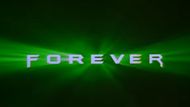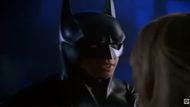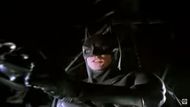After almost thirty years hidden away in the Batcave, Joel Schumacher’s original vision of Batman Forever is finally here, and it’s not the candy-colored blockbuster we remember.
Officially revealed at a special Warner Bros. screening in Los Angeles, the long-rumored Schumacher Cut takes audiences on a 160-minute melancholy odyssey that leans heavily into the shadows of Bruce Wayne’s psyche, pulling back the campiness to reveal a dark and moody version of the Caped Crusader.
Now that this darker, more mature version has emerged, fans and critics alike are wondering: could this be the redemption arc DC never knew it needed?
Why Schumacher's cut didn't make it to theaters

The Schumacher Cut was made during the post-production phase of the film in 1995. Joel Schumacher presented Warner Bros. a 160-minute cut of Batman Forever and wanted to focus on Bruce Wayne's inner conflict and provide a darker interpretation of the criminal psychologies of Gotham.
The studio made considerable changes because they thought it might stir controversy with its darker themes. To make the film more family-friendly and reduce its depth and broody tones, about 38 minutes of the film were cut out.
Writer and filmmaker Kevin Smith saw the Schumacher Cut of Batman Forever and verified some of the alterations, despite the film not being public yet. He has also held several screenings for the film.
Akiva Goldsman, who was the screenwriter for the film, told Collider about Schumacher's cut and said,
"It was darker. Bruce was haunted by his past. He felt guilt. It’s all the stuff you read. None of that is mysterious. It was a more modern interpretation of the narrative, and what’s not dissimilar to those [stories] that we sort of caught up with now. I’ve seen it. It was put back together.”
Exploring Batman Forever– The Schumacher Cut

The Schumacher Cut isn’t just a longer version of Batman Forever. It’s practically a different film. Gone are many of the neon-drenched excesses and cartoonish tonal swings that defined the 1995 theatrical release.
In their place, we get a version of Bruce Wayne that’s burdened, haunted, and grappling with his dual identity in ways more reminiscent of Tim Burton’s gothic take than the studio-friendly direction Schumacher was pushed toward.
The film opens with a completely different tone: Two-Face’s escape from Arkham Asylum, complete with a bloody message scrawled across the walls: “The Bat Must Die.” This unsettling opening sets the mood for what follows: an intimate, often psychological exploration of Bruce’s guilt over his parents’ deaths, his fear of losing himself to the Batman persona, and the emotional cost of carrying the weight of Gotham on his shoulders.
One rare long-story sequence that was much debated by fans was Bruce confronting a giant bat in a cryptic, unreal vision. The sequence was dark and ominous, uncovering Schumacher's original vision of Bruce and his splintered psyche.
In another scene, Bruce also spends time reading his father's journal. A quiet but monumental moment that re-frames his vigilante act from revenge to healing and acceptance.
This narrative continuity between the Burton movies and Schumacher's film is a significant tonal and story shift. The film then introduces Bruce Wayne at Wayne Enterprises, strolling through the halls and receiving a message from Edward Nygma- a much more grounded reveal than the theatrical cut's sudden lab sequence.
Bruce leaves for a significantly expanded action sequence to stop Two-Face's bank robbery. There is a longer sequence of Two-Face informing the bank staff he is going to rob them, plus more of a build-up to Bruce Wayne reacting, establishing at least the first half of the movie that Two-Face is the main antagonist, and not the Riddler.
Rewriting the legacy of the superhero

What makes this release so significant is that it forces a reevaluation of Schumacher as a filmmaker and Batman Forever as a film. Until now, Schumacher’s name was often unfairly associated with the campy decline of the '90s Batman era.
But the Schumacher Cut proves he had a deeper, more emotionally intelligent story to tell all along, one that was buried under studio mandates and merchandising pressure.
More importantly, this release follows in the footsteps of the Snyder Cut, another once-dismissed director’s vision that found new life through fan demand and retrospective appreciation.
The success of Zack Snyder’s Justice League showed that alternate cuts can spark fresh cultural conversations and even reshape the canon. Now, the Schumacher Cut is doing the same for Batman Forever, offering a version of Bruce Wayne that feels more in line with modern interpretations of the character, emotionally layered, psychologically conflicted, and resolutely human.
The Schumacher cut is so much more than just a re-release

The release of the Schumacher Cut isn’t just a gift to long-time Batman fans, it’s a reminder of how much untapped potential still lies in the archives of comic book cinema.
In restoring Schumacher’s original vision, Warner Bros. has not only redeemed a misunderstood entry into the Batman saga but also opened the door for reexamining how studio interference, tonal shifts, and marketing demands have shaped the legacy of superhero films.
More than a nostalgia trip, this version of Batman Forever is a bold reassertion of character-driven storytelling in a genre often dominated by spectacle. It bridges the gap between the gothic introspection of Burton’s films and the grit of Nolan’s trilogy, reminding us that Batman has always been most compelling when he’s confronting not just villains, but himself.
If the Schumacher Cut proves anything, it’s that director-driven storytelling still matters, and sometimes, history deserves a rewrite.
Batman Forever– The Schumacher Cut will be screened at CineFile Video in L.A. on May 29, 2025.
Love movies? Try our Box Office Game and Movie Grid Game to test your film knowledge and have some fun!
